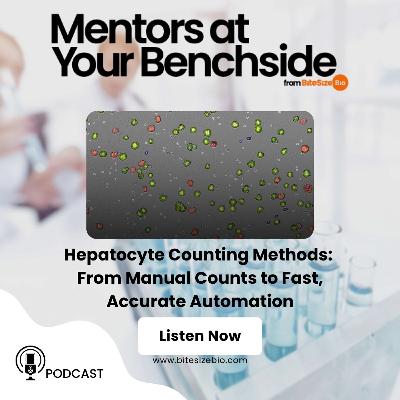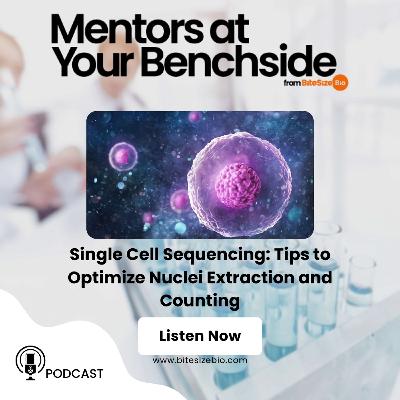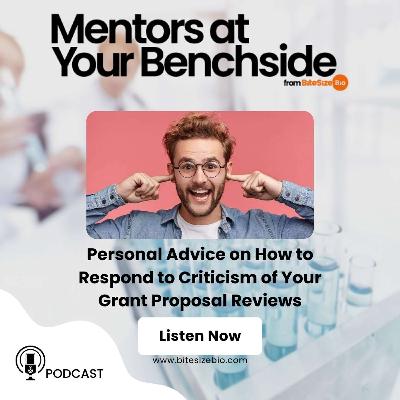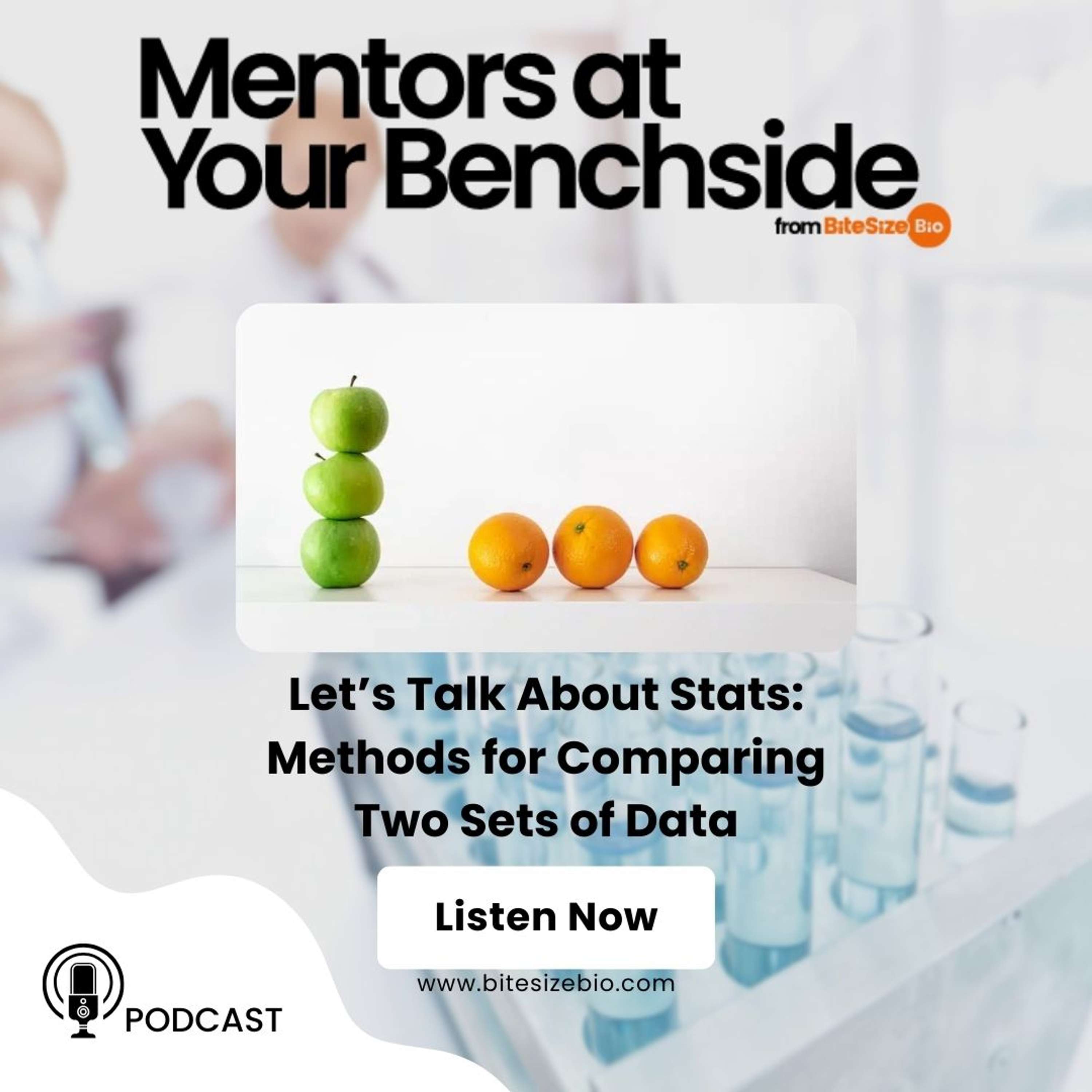Discover Mentors at Your Benchside
Mentors at Your Benchside

Mentors at Your Benchside
Author: Bitesize Bio
Subscribed: 17Played: 308Subscribe
Share
© 2022, 2023, 2024 Bitesize Bio
Description
A good mentor can be the difference between success and failure. But what to do if you don't have help on hand? Mentors At Your Benchside provides curated help and advice from experienced researchers on various topics, from lab skills and techniques to career progression.
Each short episode is bursting with easy-to-access help and advice that can improve your results and help you get the most out of your time in the lab.
https://bitesizebio.com/mentors-at-your-benchside
Each short episode is bursting with easy-to-access help and advice that can improve your results and help you get the most out of your time in the lab.
https://bitesizebio.com/mentors-at-your-benchside
115 Episodes
Reverse
#115 — Hepatocytes are liver cells that are essential for its function. They are also essential for certain branches of drug testing and diagnostics.However, they have irregular shapes, multiple nuclei, and can clump, which makes them difficult to process and count accurately. In this episode, we explain how to prepare the best hepatocyte samples possible. We also explain the latest automated machine learning-based tools that make hepatocyte counting easy and do essential sample-based calculations for you, removing tedious math. See the full article here. [1]For more details on the machine learning technology discussed in this episode, read this technical note. [2] And to hear more from DeNovix experts on hepatocyte counting, watch their webinar Automated Hepatocyte Counting: New Technology for Simple, Reliable Counts. [3]Resources:1. Hepatocyte Counting Methods: From Manual Counts to Fast, Accurate Automation. Available at: https://bitesizebio.com/83141/hepatocyte-counting-methods/2. TN 228 Automated Counting of Hepatocytes. Available at: https://www.denovix.com/tn-228-automated-counting-of-hepatocytes/?utm_source=bitesizebio&utm_medium=technicalcontent&utm_campaign=hepatocytes3. Automated Hepatocyte Counting: New Technology for Simple, Reliable Counts. Available at: https://events.bitesizebio.com/automated-hepatocyte-counting-new/room
#114 — High-quality nuclei extraction is pivotal for many genetic and epigenetic studies, including single cell RNA-seq to describe transcriptomic profiles and gene expression dynamics and ATAC-seq to determine chromatin accessibility.But nuclei samples are extremely delicate and can be challenging to prepare and count. In this episode, we provide some practical tips to prepare high-quality nuclei extracts and tailor your extraction protocol to your sample. We also compare methods to count nuclei, assess their quality, and demonstrate how automated nuclei counting can improve your workflow.Check out the original article for a graphic that shows you the level of purity and quality you should aim for with nuclei extraction. [1] If you want to learn more about automated nuclei counting, download this free eBook. [2] Read this article to learn how to count cells quickly using fluorescence microscopy. [3] And to hear directly from DeNovix experts on nuclei counting, watch their webinar Optimizing Nuclei Extraction & Counting for Single Cell Sequencing. [4]Resources: 1. Single Cell Sequencing: Tips to Optimize Nuclei Extraction and Counting. Available at: https://bitesizebio.com/78877/optimizing-nuclei-extraction/2. Automated Counting of Isolated Nuclei. Available at: https://www.denovix.com/ebook/automated-counting-of-isolated-nuclei?utm_source=bitesizebio&utm_medium=technicalcontent3. Quick and Easy Automatic Cell Counting in 4 Steps. Available at: https://bitesizebio.com/30184/quick-easy-automatic-cell-counting/4. Optimizing Nuclei Extraction & Counting for Single Cell Sequencing. Available at: https://events.bitesizebio.com/optimizing-nuclei-extraction/room
#113 — Learning how to respond to criticism is an unavoidable aspect of grant applications. Follow all instructions from funding agencies to avoid immediate rejection.This episode of Mentors At Your Benchside gives you some simple strategies to ensure you respond to criticism in a constructive and proportionate way.For example, identifying reviewers can help you tailor your responses, but don't mention them by name! Plus, using a two-column document to systematize the criticisms and responses is a great way to organize feedback and distance yourself emotionally from it.Hit play for more tips, check out the original article for links to helpful resources [1], and check out our complete guide to funding series for advice on getting your research funded—directly from a former NIH grant reviewer [2].Resources:1. Personal Advice on How to Respond to Criticism of Your Grant Proposal Reviews. Available at: https://bitesizebio.com/80095/respond-to-criticism/2. The Complete Guide to Funding I: How to Become an Expert at Getting Funded. Available at: https://events.bitesizebio.com/the-complete-guide-to-funding-i-how/join
#112 — Isoelectric focusing (IEF) is a powerful technique distinct from the more familiar SDS-PAGE, [1,2] tailored for separating proteins or peptides based on their isoelectric points (pI). [3]This method capitalizes on the migration of charged molecules through a stable pH gradient until they reach a zone where their net charge is zero, halting their movement.Essential to setting up an IEF experiment are the IPG strips, equipped with a pH-responsive gel, and the sample, often mixed with carrier ampholytes for efficient migration.IEF's utility spans various applications, from enhancing 2D-PAGE protein separations to analyzing post-translational modifications and preparing samples for mass spectrometry. [4]Discover more about how this technique can advance your research and streamline your experimental workflows.Resources:1. How SDS-PAGE Works. Available at: https://bitesizebio.com/580/how-sds-page-works/2. Isoelectric Focusing: A Simple Way to Enhance Your Protein Separation. Available at: https://bitesizebio.com/26811/isoelectric-focusing-separation-proteins-peptides/3. The Definitive Guide to pH, pKa, and pI. Available at: https://bitesizebio.com/9425/what-is-ph-pka-pi/4. Detecting Post-Translational Modifications. Available at: https://bitesizebio.com/49322/detecting-post-translational-modifications/
#111 — In this episode, we dive deep into the fascinating world of microbes and their revolutionary applications in biotechnology. From environmental solutions to breakthroughs in health and medicine, microbes hold the key to some of the most advanced scientific developments.Discover how these microscopic organisms are transforming industries and pushing the boundaries of what's possible in science and technology. We’ll explore the latest research and applications that are shaping the future.For an in-depth look at this topic, make sure to read the corresponding article on our website. [1] Dive into an application you almost certainly know about, yeast two-hybrid assays, [2] and check this article out to learn how to increase protein expression in plants. [3]Resources:1. Top 10 Uses of Microbes in Biotechnology. Available at: https://bitesizebio.com/48446/microbes-biotechnology/2. Split Ubiquitin Yeast Two-Hybrid. Available at: https://bitesizebio.com/25286/split-ubiquitin-yeast-two-hybrid/3. P19 to the Rescue: How to Increase Protein Expression in Agroinfiltration. Available at: https://bitesizebio.com/29964/p19-increase-expression-agroinfiltration/
#110 — Comparing two sets of data is a fundamental process in statistical analysis, crucial for drawing meaningful conclusions across various fields. Whether it's for determining the success of an intervention, understanding market trends, or validating scientific research, the need for comparison arises.This episode delves into the essence of data comparison, focusing on two prevalent statistical tests: the Student’s t-test and the Mann–Whitney U test. [1] Each test comes with its assumptions and applicability, making the choice between them critical depending on the nature of your data.Read our related article to learn more about comparing multiple datasets. [2]Resources:1. Let’s Talk About Stats: Methods for Comparing Two Sets of Data. Available at: https://bitesizebio.com/19298/comparing-two-sets-of-data/2. Let’s Talk About Stats: Getting the Most out of your Multiple Datasets with Post-hoc Testing. Available at: https://bitesizebio.com/19318/lets-talk-about-stats-getting-the-most-out-of-your-multiple-datasets-with-post-hoc-testing/
#109 — How do you build a scientific network that gives you the best chance of getting your research funded? How can you identify who to include in your network, and how should you contact them?This episode explains how to build a scientific network that works for you. We discuss the answers to these questions and provide some examples of collaborations that ended well—and some that didn't. Check out our online article for additional resources to help get your research funded. [1] If you struggle to convey the impact of your research, you should definitely check out our webinar on this topic. [2] Plus, you can find more direct funding advice from Joel Berry here. [3]Resources:1. Personal Advice on Building Your Professional Network. It Takes a Village. Available at: https://bitesizebio.com/77734/professional-network/2. How to Effectively Communicate Your Research. Available at: https://events.bitesizebio.com/how-to-effectively-communicate-your-1/join3. How to Become an Expert at Getting Funded. Available at: https://bitesizebio.com/77308/how-to-become-an-expert-at-getting-funded/
#108 — What should you use to fix your cells? Alcohols or aldehydes? Gluteraldehyde or formaldehyde? And how long will your cells stay fixed?This episode explains the four main fixatives for histology and cytometry and when to use them. It also provides some practical tips to ensure your fixation works and explains the benefits of combining fixatives. Check out the corresponding article for links to related resources. [1] To learn more about autofluorescence and the controls you need to check for it, read this article. [2]Resources1. 4 Fixatives for Histology and Cytometry. Perfect Your Preservation. Available at: https://bitesizebio.com/22141/fixation-and-flow-cytometry/2. 5 Controls for Immunofluorescence: A Beginner’s Guide. Available at: https://bitesizebio.com/44370/controls-for-immunofluorescence-a-beginners-guide/
#107 — Need to give your microscope a quick clean to get rid of some grime but unsure what cleaning agent to use? Have you had a nasty sample on there recently and need to disinfect it for the next user?This episode gives you a quick guide to disinfecting your microscopes, including what solvents are safe to use and the parts you should tackle first.Check out the corresponding article for helpful references. [1] To get a better understanding of the safety of your samples and other people's, read our introduction to safety datasheets. [2]Resources:1. Microscope Disinfection: A Quick Guide. Available at: https://bitesizebio.com/47987/microscope-disinfection/2. Deciphering your Materials Safety Data Sheet. Available at: https://bitesizebio.com/21848/deciphering-your-materials-safety-data-sheet/
#106 — Transforming a tissue sample into a slide ready for microscopic exploration involves a series of critical steps. Among these, tissue processing is a fundamental phase bridging tissue fixation and the embedding/sectioning of paraffin blocks.In this episode, discover what exactly happens in this vital in-between stage, and learn about the six steps that ensure your samples are ready for microscopic examination. [1]And while you're here, check out our related articles on tissue fixation and embedding/sectioning [2,3], and the five important stages in histology slide preparation. [4]Resources:1. Tissue Processing For Histology: What Exactly Happens? Available at: https://bitesizebio.com/13469/tissue-processing-for-histology-what-exactly-happens/2. An Introduction To Fixation For Histology: Think Before You Fix! Available at: https://bitesizebio.com/13401/think-before-you-fix/3. Tissue Embedding and Sectioning: Something to Think About Whilst in the Bath. Available at: https://bitesizebio.com/13414/tissue-embedding-and-sectioning-something-to-think-about-whilst-in-the-bath/4. How Histology Slides Are Prepared. Available at: https://bitesizebio.com/13398/how-histology-slides-are-prepared/
#105 — You may be familiar with standard single fragment ligations: insert, vector, ligase—done! But what if you have a complex cloning project with a massive region of DNA to clone? You can’t PCR the whole thing, and you can’t cut the entire thing out from somewhere else. What do you do?In this episode, we explain the answer: multiple fragment ligation.Check out the corresponding article for some handy illustrations and links to related resources. [1] To discover more ways to go about molecular cloning, check out these five approaches. [2] And read this article to dive deeper into how ligation works. [3]Resources:1. Multiple Fragment Ligation: The Why and How. Available at: https://bitesizebio.com/67124/multiple-fragment-ligation/2. Cloning Methods: 5 Different Ways to Assemble. Available at: https://bitesizebio.com/26961/cloning-methods-5-different-ways-to-assemble/3. DNA Ligation: How it Works & 6 Top Tips. Available at: https://bitesizebio.com/10279/how-dna-ligation-works/
#104 — What funding stream is right for you? Industry or government? Non-profits or crowdfunding? It depends on what you're researching, but also where you want to take your career. In this episode, Joel Berry, Founder, and Chief Scientist at Astound Research, breaks down the different funding streams and flow of money in bioscience research. Discover the scope and requirements of each type of funding source, and get a breakdown of the overall funding landscape so you can pick the funding stream that works best for you. Check out the corresponding online article for links to more helpful funding resources. [1] Plus, discover how you can advocate for science funding [2] and dive deeper into whether crowdfunding will work for your project. [3]Resources:1. Funding Opportunities and the Flow of Money in Science. Available at: https://bitesizebio.com/77353/funding-opportunities-landscape/2. Defend Science Funding! A Brief Guide. Available at: https://bitesizebio.com/36701/defend-science-funding/3. Kick Start Your Research With Crowdfunding! Available at: https://bitesizebio.com/20876/kick-start-your-research-with-crowdfunding/
#103 — DNA sequencing is a fundamental technique in modern molecular biology that has revolutionized the study of genes.In the old days, Maxam–Gilbert sequencing was the method of choice, but it has mostly been replaced by Sanger sequencing and Next-Generation methods.Yet, it still has some niche uses, and in the historical context of DNA sequencing, it’s hugely important!So, in this episode, learn about what Maxam–Gilbert sequencing is, why it lost popularity, and why some researchers still use it today.Check out the corresponding article to see if you can read a Sanger sequencing gel and decipher the final amino acid code. [1] And check out our primer on the Sanger sequencing method to learn why it was so advantageous over the Maxam–Gilbert method. [2]Resources:1. Maxam–Gilbert Sequencing: What It Is and 3 Modern Applications. Available at: https://bitesizebio.com/36696/maxam-gilbert-sequencing/2. Sanger Sequencing: How the Genome Was Won. Available at: https://bitesizebio.com/27985/sanger-sequencing-genome-won/
#102 — Fluorescence microscopy images not only look great but also allow us to get a better understanding of cells, structures, and tissues. And confocal laser scanning microscopy lets us construct 3D images from 2D micrographs. In this episode, learn the basic principles of confocal laser scanning microscopy, how the microscopes work, and some of its applications in bioscience and beyond. Check out the corresponding article for a handy confocal laser scanning microscope diagram. [1] Learn about the Airy unit [2] and check out our guide to choosing a fluorescent protein for your experiments. [3]Resources:1. Confocal Laser Scanning Microscopy Explained In 3 Easy Steps. Available at: https://bitesizebio.com/19958/confocal-laser-scanning-microscopy/2. Rubbing Your Microscope’s Eyes: A Guide to Optical Resolution. Available at: https://bitesizebio.com/13415/rubbing-your-microscopes-eyes-a-guide-to-optical-resolution/3. The Ultimate Guide to Choosing a Fluorescent Protein. Available at: https://bitesizebio.com/54287/choosing-a-fluorescent-protein/
#101 — Discover what it takes to become an expert at getting funded, from simple habits such as summarizing what you read in the literature, to big steps such as organizing your very own conference to establish your name in your field.With over 30 years of experience as a biomedical engineering researcher seeking grants, Joel Berry, Founder, and Chief Scientist at Astound Research, shares his hard-won insights on strategizing your approach to seeking grants. [1] Take a listen to what he has to say. If you're struggling to keep up to date with the literature in your field, read our tips for staying on top of new publications [2] and get more grant writing advice from a grant reviewer! [3]Resources:1. How to Become an Expert at Getting Funded. Available at: https://bitesizebio.com/77308/how-to-become-an-expert-at-getting-funded/2. Useful Tips to Keep on Top of New Literature. Available at: https://bitesizebio.com/10532/search-engines-for-literature-searching/3. What I Learned as a Grant Reviewer. Available at: https://bitesizebio.com/30909/learned-grant-reviewer/
#100 — Science attracts so many different and quirky personalities that you are bound to have some people you just don’t get along with. Conflicts happen, and there are many strategies you can take to deal with conflict in the lab. But when your lab supervisor is the problem, it can be a big issue for you.In this episode, delve into the challenges of dealing with difficult lab supervisors. [1] We identify five common problematic personality traits: passive-aggressive, manipulative, unfocused, micro-manager, and negative reinforcement. Listen and explore practical strategies for addressing each type while remaining professional and constructive.Check out our related article for further advice on dealing with conflicts in a busy research lab. [2]Resources:1. Five Types of Difficult Lab Supervisor and How to Handle Them. Available at: https://bitesizebio.com/1540/6-types-of-bad-boss-and-how-to-handle-them/2. Dealing with Tension and Conflict in the Lab. Available at: https://bitesizebio.com/27373/dealing-tension-conflict-lab/
#99 — So you’ve got your flow cytometry training booked and are one step closer to that precious data.But if you want to hit the ground running and get some useful data from your samples, there are some little things you'll need to do.These include reading up on a bit of background theory, understanding the capabilities of different types of cytometers, and thinking about what you want to learn from your experiment.In this episode of Mentors At Your Benchside, we've compiled cytometry training advice from a core facility manager to help you get the most out of your training sessions and early experiments. [1]While you are here, why not learn about the components inside cytometers and what they do? [2] Plus, take a step towards fully understanding your data and explore the difference between forward scatter, side scatter, and their corresponding plots. [3]Resources:1. Seven Top Tips to Make the Most of Your Flow Cytometry Training. Available at: https://bitesizebio.com/75182/flow-cytometry-training/2. Demystifying the Flow Cytometry Optics System: A Peek Under the Hood. Available at: https://bitesizebio.com/31638/flow-cytometry-optics-system/3. Basic Parameters Measured by a Flow Cytometer: What is Scattered Light and Absolute Fluorescence? Available at: https://bitesizebio.com/25310/basic-parameters-measured-by-a-flow-cytometer-what-is-scattered-light-and-absolute-fluorescence/
#98 — Our labs can contain thousands of chemicals, many of which will be past their given expiry date and many of which are expensive to buy and replace. Replacing them when you don't need to can be a waste of time and grant money. On the other hand, using expired chemicals can lead to failed experiments and confusing results. In this episode of Mentors At Your Benchside, learn what types of chemicals are safe to use past their expiry date, which ones you should probably throw out, and why.Read out the corresponding article for a handy summary table. [1] And while you're diving into reagents, why not check out the different types of antibiotics in molecular biology? [2] Resources:1. What Reagents Can You Use Past Their Chemical Expiry Date? Available at: https://bitesizebio.com/74311/chemical-expiry-date/2. Antibiotics Used in Molecular Biology. Available at: https://bitesizebio.com/10288/antibiotics-used-in-molecular-biology/
#97 — A research interest statement is essential to successfully apply for an academic job. In this episode, we delve into how to craft an outstanding one. [1]We cover strategies to outline your past, current, and future research in a concise format. We also explain other key elements such as, creating a compelling introduction, detailing research plans, aligning with targeted labs or departments, and writing a strong conclusion. Plus, get tips on personalizing your applications while maintaining clarity and conciseness.While you're here, check out our related article packed with tips to help you shine at your next job interview. [2] Or, if you're considering working abroad, check out some of its pros and cons. [3]Resources:1. How to Write a Killer Research Interest Statement. Available at: https://bitesizebio.com/35364/position-research-interest-statement/2. How To Shine in a Job Interview. Available at: https://bitesizebio.com/2599/how-to-shine-in-a-job-interview/ 3. The Pros and Cons of a PhD or Post-doc in a Foreign Country. Available at: https://bitesizebio.com/7300/the-pros-and-cons-of-a-phd-or-post-doc-in-a-foreign-country-2/
#96 — An appropriate microorganism preservation method can make all the difference in maintaining the viability of your microbial strains because it plays a crucial role in ensuring reproducible results and continuity in research.In this episode, learn the preservation methods for short- and long-term microbe storage, their pros and cons, and the kit you need to do them.Check out the corresponding article for a list of helpful references. [1] Learn the main ingredients of cell culture media [2] and the steps you can take to keep mammalian cell cultures healthy. [3]Resources:1. How to Preserve Microorganisms: Store Your Cells Better. Available at: https://bitesizebio.com/45159/how-to-preserve-microorganisms/2. What’s in Your Cell Culture Medium? Available at: https://bitesizebio.com/37034/cell-culture-medium/3. How To Keep Your Mammalian Cells Happy And Healthy. Available at: https://bitesizebio.com/8146/how-to-keep-your-cells-happy-and-healthy/
























